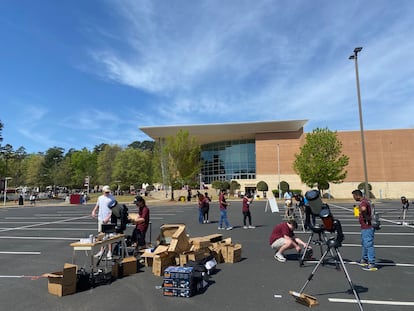Solar eclipse: A shadow beam crosses America
The interposition of the moon between the Earth and the sun becomes a mass spectacle followed by millions of people across North America


Once revered or feared, eclipses have now become a mass spectacle. A cosmic spectacle in which the moon comes between the Earth and the sun. Although the moon is 400 times smaller than the Sun, it is 400 times closer, so the overlap of the two is almost exact. This Monday, the moon blocked out the sunlight, casting a shadow that diagonally crossed North America, from Mazatlán, México, to Newfoundland, Canada. In Little Rock, Arkansas, a midway point in the path of the total eclipse, thousands of people gathered to see the sun magically turn on and off.
As in so many places along the path of the total eclipse, the darkening was gradual on the campus of the University of Arkansas at Little Rock. It was very slow at first as the phenomenon began and nerves were unsettled. The penumbra imposed itself and the temperature began to drop as the total eclipse approached. Suddenly, the birds began to sing in bewilderment.
At 1:51 p.m. local time, the moon completely blocked out the sun, bringing with it a moment of disconcerting darkness that lasted for about three minutes. Sighs of amazement and shouts of euphoria overtook thousands of people who gathered on the campus as the sun went away. Then, in that indescribable moment when the sun was completely covered and only a ring of light could be seen around the moon, there was only silence in the face of the majestic celestial spectacle.

Afterward, the sun emerged again at full speed, to the confusion of the animals, especially the birds, who are so dependent on sunlight for the timing of their routines. People were still impressed by what they had just seen.
“We drove seven hours from Mississippi. It was worth it,” said Jonathan, 47, who drove to Little Rock from Hattiesburg because he had seen that the weather forecast was good in Arkansas. He arrived on Sunday, watched the eclipse with his wife and three children and then got back on the road. The weather forecast was the major concern for eclipse chasers in the United States on Monday, as clouds threatened to ruin the show in much of the country.
“It’s kind of amazing, the darkness at noon,” noted Miles Blanton, a physics professor at the University of Arkansas. “It’s so predictable that it almost feels like we make it happen, like we’re in control. So punctual that it gives us that false sense of control,” he added. “It’s mind-blowing, I’ve never seen anything like it,” Gavin of Little Rock said at the time of the total eclipse.
The whole of North America woke up to the astronomical phenomenon. In the United States, television channels hardly talked about anything else. ABC interviewed the singer of the unofficial anthem of any eclipse. “I still get excited when I hear the song on the radio,” Bonnie Tyler said. “Every time the eclipse comes, everyone all over the world, they play ‘Total Eclipse of the Heart’ and I never get tired of singing it,” she added, as she broke into a few notes live on Good Morning America. All the major networks were connecting with different places along the path of the total eclipse, where large events had been organized partly for entertainment and partly for scientific outreach.
“It’s a big tourist event,” explains Michael Pakko, professor of economics at the University of Arkansas at Little Rock. “That’s how it’s going to have its biggest impact on the economy. We’re expecting a lot of out-of-state visitors to see the eclipse, and while they’re here, they’re staying in hotels, restaurants, buying groceries, things like that. My estimates are that 460,000 people would be visiting Arkansas today. It’s an event comparable only to a Super Bowl or a political party convention,” he adds.
Perryman Group calculated the potential economic benefits associated with the eclipse and estimated that the United States is likely to experience an increase in direct visitor spending of nearly $1.6 billion. “When the multiplier effects on the economy are taken into account, the expected economic impact rises to $6 billion, with an increase of $3 billion in gross product and $1.8 billion in personal income for U.S. residents. Total spending per state (including multiplier effects) will range from $2.1 billion in New Hampshire to $1.4 billion in Texas,” the report explained. Solar power generators will be negatively impacted; as much as 60 Gw could be lost. In any case, storms and clouds already disrupt production every day, making it perfectly manageable for the grid.
All kinds of activities were organized along the path of the total eclipse, as well as in many other areas. In New York there were numerous events and people rushed to Central Park with their telescopes and eclipse glasses; there were also events to follow the eclipse on top of skyscrapers, on boats and in public parks. Those who could do so left the city for places of complete darkness, causing heavy traffic jams both on the way there and on the way back.
The path of the total eclipse made landfall in Mazatlán, México, on the Pacific coast, at 11:07 a.m. local time. After casting its shadow in Durango, Torreón and Monclova, it crossed into the United States through the busy Eagle Pass border crossing at 1:27 p.m. local time. In Texas, it also covered San Antonio, Austin and Dallas after noon. On its way north, the eclipse darkened Little Rock, Arkansas, before continuing on to Indianapolis, Indiana; Cleveland, Ohio; and Buffalo, New York. At the Canadian border, the path of the total eclipse includes Niagara Falls, skims Toronto, and completely blocks out the sun over part of Montreal before heading into the North Atlantic via Newfoundland. The towns of Cape Girardeau, Missouri, and Carbondale, Illinois, which were already in the path of the 2017 eclipse, were also in its path in 2024.

Approximately 44 million people live along the path of the total eclipse, and another 200 million in a 186-mile-wide band of significant darkening, making it the most-watched continental eclipse in history. In large cities on the East Coast like New York, Washington, Boston and Philadelphia, the eclipse was also visible even though they were not in the path of the total eclipse.
The next total solar eclipse in the United States will not be until 2033 and will be limited to Alaska. In 2044, the moon’s shadow will darken western Canada, Montana and North Dakota. In 2045, a total solar eclipse will cross the country from California to Florida. The next two solar eclipses will pass over the Iberian Peninsula. The one on August 12, 2026, will cross the northern half of the Peninsula. The one on August 2, 2027, will cover the southernmost part of Andalusia, Spain.
At the University of Arkansas, in Little Rock, Total Eclipse of the Heart was played at full volume over the public address system as soon as the sun appeared again. Some people were encouraged to chant it.
Sign up for our weekly newsletter to get more English-language news coverage from EL PAÍS USA Edition
Tu suscripción se está usando en otro dispositivo
¿Quieres añadir otro usuario a tu suscripción?
Si continúas leyendo en este dispositivo, no se podrá leer en el otro.
FlechaTu suscripción se está usando en otro dispositivo y solo puedes acceder a EL PAÍS desde un dispositivo a la vez.
Si quieres compartir tu cuenta, cambia tu suscripción a la modalidad Premium, así podrás añadir otro usuario. Cada uno accederá con su propia cuenta de email, lo que os permitirá personalizar vuestra experiencia en EL PAÍS.
¿Tienes una suscripción de empresa? Accede aquí para contratar más cuentas.
En el caso de no saber quién está usando tu cuenta, te recomendamos cambiar tu contraseña aquí.
Si decides continuar compartiendo tu cuenta, este mensaje se mostrará en tu dispositivo y en el de la otra persona que está usando tu cuenta de forma indefinida, afectando a tu experiencia de lectura. Puedes consultar aquí los términos y condiciones de la suscripción digital.
More information
Archived In
Últimas noticias
Miguel Alandia, the artist whose murals were saved by miners under Bolivia’s military rule
What are men searching for (and running from) when they go on a retreat?
Why we lost the habit of sleeping in two segments and how that changed our sense of time
Meet Fly, the guardian of the hawksbill sea turtles on Santa Catalina Island
Most viewed
- Liset Menéndez de la Prida, neuroscientist: ‘It’s not normal to constantly seek pleasure; it’s important to be bored, to be calm’
- December Social Security and SSI payments: Dates, double checks and the 2026 COLA increase
- Christian Louboutin: ‘Young people don’t want to be like their parents. And if their parents wear sneakers, they’re going to look for something else’
- The low-cost creative revolution: How technology is making art accessible to everyone
- The Florida Keys tourist paradise is besieged by immigration agents: ‘We’ve never seen anything like this’










































